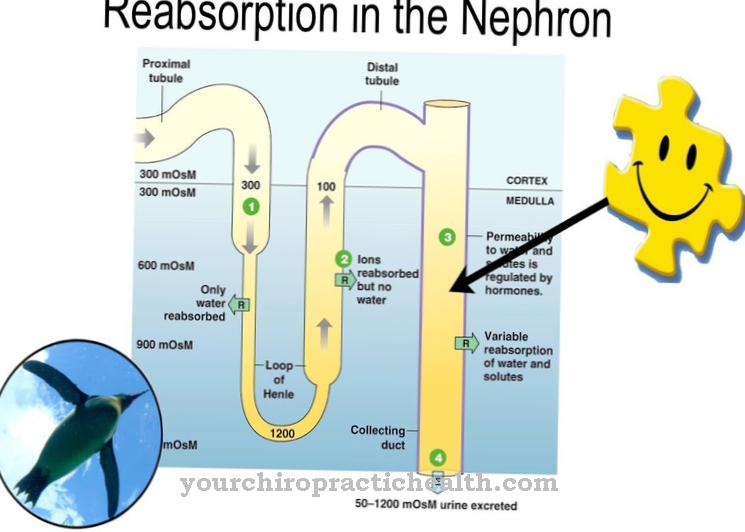Of the Fatty acid breakdown serves to generate energy in the cells and takes place via what is known as beta oxidation. In the course of beta oxidation, acetyl-coenzyme A is formed, which is further broken down into carbon dioxide and water or fed back into the citric acid cycle. Disturbances in the breakdown of fatty acids can lead to serious illnesses.
What is Fatty Acid Breakdown?

Besides the breakdown of glucose in the organism, the breakdown of fatty acids is an important metabolic process for generating energy in the cell.
The fatty acids are broken down in the mitochondria. The degradation takes place via the so-called beta oxidation. The term "beta" originated from the fact that the oxidation takes place on the third carbon atom (beta carbon atom) of the fatty acid molecule.
At the end of an oxidation cycle, two carbon atoms are split off in the form of activated acetic acid (acetyl-coenzyme A). Since the breakdown of a fatty acid requires several oxidation cycles, the process was formerly also known as the fatty acid spiral.
Acetyl coenzyme is broken down further in the mitochondria into ketone bodies or carbon dioxide and water. When it gets back into the cytoplasm from the mitochondrion, it is fed back into the citric acid cycle.
More energy is produced in the breakdown of fatty acids than in the burning of glucose.
Function & task
The breakdown of fatty acids takes place in several reaction steps and takes place within the mitochondria.First of all, the fatty acid molecules are located in the cytosol of the cell.
They are inert molecules that first have to be activated for degradation and transported into the mitochondria. To activate the fatty acid, coenzyme A is transferred with the formation of acyl-CoA. First, ATP is split into pyrophosphate and AMP. AMP is then used to form acyl AMP (acyl adenylate).
After the AMP has been split off, the fatty acid can be esterified with coenzyme A to form acyl-CoA. Then, with the help of the enzyme carnitine acyltransferase I, carnitine is transferred to the activated fatty acid.
This complex is transported into a mitochondrion (mitochondrial matrix) by the carnitine-acylcarnitine transporter (CACT). There, carnitine is split off again and coenzyme A is transferred again. The carnitine is channeled out of the matrix and acyl-CoA is available in the mitochondrion for the actual beta oxidation.
The actual beta oxidation takes place in four reaction steps. The classic oxidation steps take place with even-numbered saturated fatty acids. If odd-numbered or unsaturated fatty acids are broken down, the starting molecule must first be prepared for beta oxidation through further reactions.
The acyl-CoA of even-numbered saturated fatty acids is oxidized in a first reaction step with the aid of the enzyme acyl-CoA dehydrogenase. This creates a double bond between the second and third carbon atom in the trans position. In addition, FAD is converted into FADH2.
Normally, the double bonds of unsaturated fatty acids are in the cis position, but the next step in the fatty acid degradation reaction can only take place with a double bond in the trans position.
In a second reaction step, the enzyme enoyl-CoA hydratase adds a water molecule to the beta carbon atom to form a hydroxyl group. The so-called L-3-hydroxyacyl-CoA dehydrogenase then oxidizes the beta carbon atom to a keto group. 3-Ketoacyl-CoA is formed.
In the last reaction step, additional coenzyme A binds to the beta-carbon atom. Acetyl-CoA (activated acetic acid) is split off and an acyl-CoA that is two carbon atoms shorter remains. This shorter residual molecule goes through the next reaction cycle up to a further cleavage of acetyl-CoA.
The process continues until the entire molecule is broken down into activated acetic acid. The reverse process to beta oxidation would also be theoretically possible, but does not take place in nature.
There is a different reaction mechanism for fatty acid synthesis. In the mitochondrion, acetyl-CoA is broken down further into carbon dioxide and water or in ketone bodies with the release of energy. In the case of odd-numbered fatty acids, propionyl-CoA with three carbon atoms remains in the end. This molecule is broken down in a different way.
When unsaturated fatty acids are broken down, the double bonds are converted from cis to trans configurations by specific isomerases.
Illnesses & ailments
Fatty acid breakdown disorders are rare, but can lead to serious health problems. Almost always, these are genetic diseases.
There is a corresponding gene mutation for almost every relevant enzyme involved in the breakdown of fatty acids. For example, a deficiency in the MCAD enzyme arises from a gene mutation that is inherited in an autosomal recessive manner. MCAD is responsible for breaking down medium-chain fatty acids. Symptoms include hypoglycemia (low blood sugar), seizures, and frequent comatose conditions. Since the fatty acids cannot be used to generate energy here, increased levels of glucose are burned. This leads to hypoglycaemia and the risk of coma.
Since the body must always be supplied with glucose for energy production, there must be no long-term food abstinence. If necessary, a high-dose glucose infusion must be administered in an acute crisis.
Furthermore, all myopathies are characteristic of mitochondrial fatty acid breakdown disorders. This leads to muscle weakness, disorders of the liver metabolism and hypoglycemic conditions. Up to 70 percent of those affected go blind in the course of their lives.
Serious diseases also occur when the breakdown of excessively long fatty acids is disturbed. These very long-chain fatty acids are not broken down in the mitochondria but in the peroxisomes. Here the enzyme ALDP is responsible for the introduction into the peroxisomes. However, when ALDP is defective, the long fatty acid molecules accumulate in the cytoplasm and thus lead to severe metabolic disorders. The nerve cells and the white matter of the brain are also attacked. This type of fatty acid breakdown disorder leads to neurological symptoms such as balance disorders, numbness, cramps and underactive adrenal glands.

























.jpg)

.jpg)
